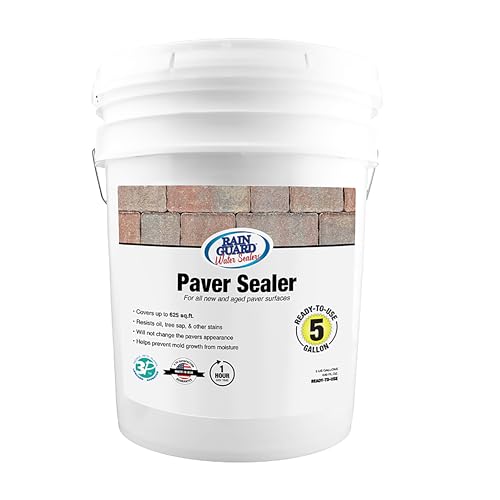If you’ve ever admired a beautifully paved driveway or patio, you might wonder how to keep it looking pristine for years to come. That’s where paver sealing comes in. It’s a process that involves applying a protective sealant to your pavers to enhance their appearance and durability.

By sealing your pavers, you not only give them a fresh, glossy look but also shield them from harsh weather conditions, oil spills, and other potential damage. This simple yet effective maintenance technique can prolong the life of your pavers and make them easier to clean and maintain.
Join us as we delve into the world of paver sealing, exploring its benefits, application methods, and why it’s a worthwhile investment for any homeowner looking to elevate the beauty and longevity of their outdoor spaces.
Understanding Paver Sealing
The Basics of Paver Sealing
As landscape designers, we know that paver sealing is a crucial aspect of maintaining the beauty and functionality of outdoor spaces. Paver sealing involves applying a protective sealant over the surface of pavers to enhance their appearance and safeguard them against various elements. This sealant acts as a barrier, preventing the intrusion of oil spills, dirt, and moisture, which can damage the pavers over time.
When we seal pavers, we create a shield that not only enhances their color and texture but also extends their lifespan. The sealant helps in preventing fading due to UV exposure, keeping the pavers looking vibrant for longer. Additionally, it makes cleaning a breeze, as sealed pavers are more resistant to stains and easier to wipe down or pressure wash.
Benefits of Sealing Your Pavers
Sealing your pavers offers a myriad of benefits that can significantly enhance the overall appeal and durability of your outdoor living spaces. By investing in paver sealing, you ensure that your driveways, patios, or walkways maintain their pristine condition for years to come. The key benefits of sealing your pavers include:
- Enhanced Aesthetic Appeal: Sealed pavers boast a rich color depth and a glossy finish, elevating the visual appeal of your outdoor areas.
- Protection Against Wear and Tear: The sealant provides a protective layer that shields your pavers from scratches, erosion, and damage caused by foot traffic or vehicular use.
- Resistance to Stains: Sealed pavers are less likely to absorb spills or stains, making them easier to clean and maintain.
- Longevity: Paver sealing helps in preserving the integrity of the pavers, ensuring they last longer and require less frequent repairs or replacements.
- Weather Resistance: Sealed pavers are better equipped to withstand harsh weather conditions, including rain, snow, and UV rays, without deteriorating quickly.
Overall, paver sealing is a cost-effective and efficient way to enhance the beauty and longevity of your outdoor hardscapes, offering both aesthetic and functional advantages that can transform your outdoor living experience.
Types of Paver Sealants
Acrylic Sealants
When it comes to sealing pavers, acrylic sealants are a popular choice among landscape designers like us. Acrylic sealants provide a durable protective layer that enhances the color of the pavers, giving them a vibrant and glossy finish. These sealants are UV-resistant, preventing the pavers from fading over time due to sun exposure. Additionally, acrylic sealants offer excellent stain resistance, making it easier to clean any spills or dirt from the surface of the pavers. Their quick-drying nature makes them ideal for areas that need to be back in use swiftly.
Water-Based Sealants
Water-based sealants are another common option we often recommend to our clients. These sealants are environmentally friendly and emit fewer odors during application, making them a more sustainable choice for outdoor spaces. Water-based sealants provide a transparent protective layer that enhances the natural colors of the pavers while offering excellent protection against moisture, oil spills, and other outdoor elements. They are easy to apply and clean up, making maintenance hassle-free for homeowners.
Solvent-Based Sealants
Solvent-based sealants are known for their long-lasting protection and durability. As landscape designers, we often suggest solvent-based sealants for high-traffic areas or locations exposed to harsh weather conditions. These sealants penetrate deep into the pavers, forming a strong barrier against stains, oil, and dirt. While they may have a stronger odor during application, solvent-based sealants offer superior protection and longevity. They are recommended for areas where maximum protection and durability are required.
In our experience, choosing the right type of paver sealant depends on factors like the desired finish, level of maintenance, and environmental considerations. Each type of sealant has its advantages, and selecting the appropriate one can significantly impact the overall look and longevity of the paved surface.
The Paver Sealing Process
Cleaning and Preparing the Pavers
In our landscape design projects, preparing the pavers before sealing is a crucial step. We start by thoroughly cleaning the surface to remove any dirt, debris, or stains that might affect the adhesion of the sealant. This ensures a smooth and uniform finish once the sealing is complete. We use a pressure washer or specialized paver cleaning solution to achieve optimum cleanliness.
Applying the Sealant
When it comes to applying the sealant, we follow a meticulous process to guarantee effective protection and enhancement of the pavers. We often use a roller, brush, or sprayer to evenly coat the surface with the chosen sealant. This helps in creating a barrier against moisture, UV rays, and other damaging elements, preserving the pavers’ aesthetic appeal and structural integrity.
Curing Time and Aftercare
After the sealant application, allowing sufficient curing time is essential to ensure its proper bonding and efficacy. We recommend avoiding foot traffic or any disturbances on the sealed pavers during this period. Once the sealant has cured, we advise regular maintenance practices like gentle cleaning with mild soap and water to prolong the life of the sealant and keep the pavers looking pristine for years to come.
When to Seal Your Pavers
As landscape designers, we understand the importance of timing when it comes to paver sealing. Here’s a guide on the optimal moments to think about sealing your pavers:
New Paver Installations
When it comes to new paver installations, sealing your pavers is a proactive step that can help protect them from the very beginning. Once the pavers are laid and the joint sand is settled, it’s usually recommended to wait for a specific period, typically around 60 days, before applying the sealant. This waiting time allows any efflorescence to dissipate and ensures that the pavers are fully cured and ready for the sealing process.
Maintenance on Existing Pavers
For existing pavers, the ideal timing for resealing largely depends on the condition of the current sealant. A good rule of thumb is to monitor the paver surface for signs of wear and tear. When you start noticing that water is not beading on the surface anymore or that the color of the pavers is fading, it’s a clear indication that it’s time to reseal. Typically, existing pavers should be resealed every 2-3 years to maintain their appearance and protect them from the elements.
By being mindful of these timings, we ensure that the pavers in our outdoor spaces remain looking their best and are well-protected for years to come.
Choosing the Right Sealant for Your Pavers
As landscape designers, we understand the significance of selecting the appropriate sealant for your pavers. The sealant plays a vital role in preserving the beauty and longevity of your outdoor spaces. Here, we will delve into essential factors to consider when choosing the right sealant and share some professional recommendations to guide you in this decision-making process.
« Unveiling the Ultimate Secret: The Best Time EVER to Seal Your Pavers Revealed 😱🔥 Discover the Surprising Secret to Choosing the Perfect Paver Sand »
Factors to Consider
When deciding on the best sealant for your pavers, several key factors should influence your choice:
- Type of Pavers: Consider the material of your pavers, whether they are concrete, brick, or stone. Different sealants are formulated to work best with specific paver materials to ensure optimal protection and longevity.
- Desired Finish: Determine the look you want to achieve. Some sealants enhance the natural colors of the pavers, while others provide a glossier finish. Understanding your preferred aesthetic will help you choose the right sealant type.
- Durability: Evaluate the durability of the sealant. Factors like UV resistance, abrasion resistance, and longevity should be considered based on the location and expected foot traffic on the paved surface.
- Maintenance: Think about the level of maintenance you are willing to undertake. Some sealants require more frequent reapplication, while others offer long-lasting protection with minimal upkeep.
Professional Recommendations
As experienced landscape designers, we recommend the following tips when selecting a sealant for your pavers:
- Consultation: If you are unsure about the best sealant for your specific paver type and location, consider consulting with a professional. They can provide tailored recommendations based on your unique requirements.
- Quality Over Cost: Opt for high-quality sealants, even if they are slightly more expensive. Investing in a premium sealant will ensure better protection and longevity for your pavers, ultimately saving you time and money on repairs and replacements.
- Compatibility Testing: Before applying a sealant to the entire paved area, conduct a small compatibility test on a discreet section. This will help you assess how the sealant interacts with your pavers and whether it achieves the desired results.
By considering these factors and following our professional recommendations, you can confidently choose the right sealant for your pavers, enhancing their appearance and ensuring their durability for years to come.
Common Misconceptions About Paver Sealing
When it comes to paver sealing, there are some common misconceptions that we often encounter as landscape designers. Let’s address these misunderstandings to provide clarity on this essential practice for enhancing outdoor spaces:
- Paver Sealing Makes Pavers Slippery: One prevalent misconception is that sealing pavers can make them excessively slippery, posing a safety hazard. While it’s true that some sealants can increase the smoothness of the surface, modern paver sealants are designed with additives that offer slip resistance, ensuring that your sealed pavers are safe to walk on even when wet.
- Sealing Pavers is a One-time Job: Another misconception is that once you seal your pavers, you never have to do it again. In reality, paver sealing is a maintenance task that needs to be periodically repeated to maintain the protective layer. Factors like foot traffic, weather exposure, and the type of sealant used can impact the longevity of the seal, necessitating resealing every few years.
- Sealing Changes the Appearance of Pavers Dramatically: Some people believe that sealing pavers drastically alters their appearance, making them look unnaturally glossy or artificially colored. The truth is that advancements in sealant formulations now offer a range of finishes, from enhancing the natural color of the pavers to providing a subtle sheen. The key is to select the right type of sealant that complements the aesthetic of your outdoor space.
- All Sealants Offer the Same Level of Protection: Not all sealants are created equal, and assuming that any product will provide the same level of protection can be misleading. Different sealants offer varying degrees of durability, UV resistance, stain protection, and breathability. It’s crucial to choose a sealant that matches the specific requirements of your pavers and the environmental conditions they are exposed to.
By debunking these misconceptions and understanding the nuances of paver sealing, we can make informed decisions to preserve the beauty and functionality of outdoor spaces effectively.
Conclusion
Understanding the ins and outs of paver sealing is key to preserving the charm and resilience of your outdoor areas. By grasping the benefits, sealant options, application steps, and upkeep tips, we empower ourselves to make wise choices. Dispelling common myths about slipperiness, longevity, aesthetics, and protection levels associated with paver sealing allows us to navigate this maintenance task with confidence. Armed with this knowledge, we can ensure that our outdoor spaces remain inviting and enduring for years to come.
















